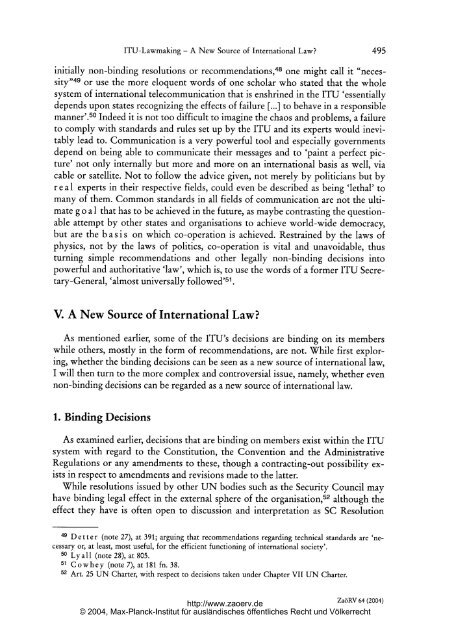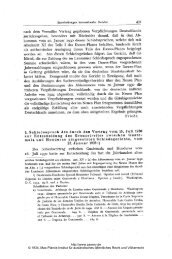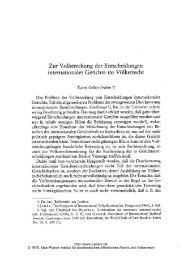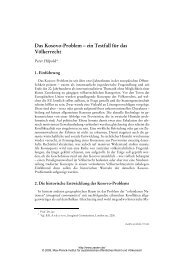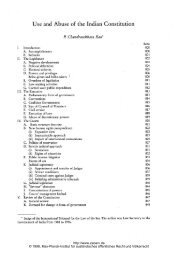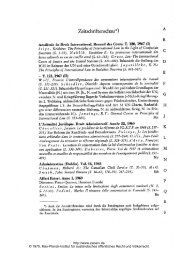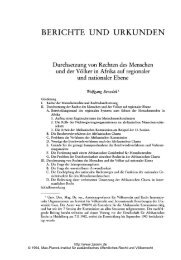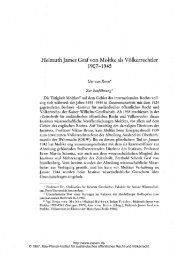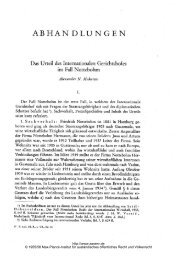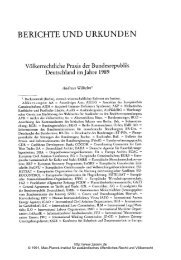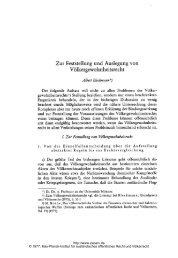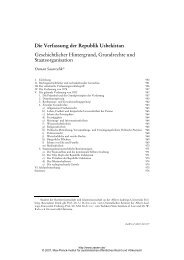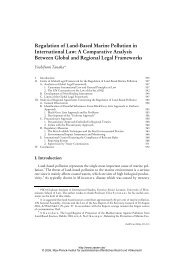The Law-Making of the International Telecommunication Union (ITU ...
The Law-Making of the International Telecommunication Union (ITU ...
The Law-Making of the International Telecommunication Union (ITU ...
You also want an ePaper? Increase the reach of your titles
YUMPU automatically turns print PDFs into web optimized ePapers that Google loves.
- <strong>ITU</strong>-<strong>Law</strong>making A New Source <strong>of</strong> <strong>International</strong> <strong>Law</strong>? 495<br />
48<br />
initially non-binding resolutions or recommendations one might call it -<br />
"neces<br />
Sityl,'49 or use <strong>the</strong> more eloquent words <strong>of</strong> one scholar who stated that <strong>the</strong> whole<br />
systern <strong>of</strong> international telecommunication that is enshrined in <strong>the</strong> <strong>ITU</strong> 'essentially<br />
depends upon states recognizing <strong>the</strong> effects <strong>of</strong> failure [ ] to behave in a responsible<br />
manner'.50 Indeed it is not too difficult to imagine <strong>the</strong> chaos and problems, a failure<br />
to comply with standards and rules set up by <strong>the</strong> <strong>ITU</strong> and its experts would inevi-<br />
tably lead to. Communication is a very powerful tool and especially governments<br />
depend on being able to communicate <strong>the</strong>ir messages and to 'paint a perfect picture-'<br />
not only internally but more and more on an international basis as well, via<br />
cable or satellite. Not to follow <strong>the</strong> advice given, not merely by politicians but by<br />
r e a 1 experts in <strong>the</strong>ir respective fields, could even be described as being 'lethal-' to<br />
many <strong>of</strong> <strong>the</strong>m. Common standards in all fields <strong>of</strong> communication are not <strong>the</strong> ulti-<br />
mate g o a 1 that has to be achieved in <strong>the</strong> future, as maybe contrasting <strong>the</strong> questionable<br />
attempt by o<strong>the</strong>r states and organisations to achleve world-wide democracy,<br />
but are <strong>the</strong> b a s i s on which co-operation is achleved. Restrained by <strong>the</strong> laws <strong>of</strong><br />
physics, not by <strong>the</strong> laws <strong>of</strong> politics, CO-Operation is vital and unavoidable, thus<br />
turning simple recommendations and o<strong>the</strong>r legally non-binding decisions into<br />
powerful and authoritative 'law', which is, to use <strong>the</strong> words <strong>of</strong> a former <strong>ITU</strong> Secre-<br />
tary-General, almost universally followed<br />
V. A New Source <strong>of</strong> <strong>International</strong> <strong>Law</strong>?<br />
As mentioned earlier, some <strong>of</strong> <strong>the</strong> <strong>ITU</strong>'s decisions are binding on its members<br />
while o<strong>the</strong>rs, mostly in <strong>the</strong> form <strong>of</strong> recommendations, are not. While first exploring,<br />
whe<strong>the</strong>r <strong>the</strong> binding decisions can be seen as a new source <strong>of</strong> international law,<br />
I will <strong>the</strong>n turn to <strong>the</strong> more complex and controversial issue, namely, whe<strong>the</strong>r even<br />
non-binding decisions can be regarded as a new source <strong>of</strong> international law.<br />
1. Binding Decisions<br />
-151<br />
As examined earlier, decisions that are binding on members exist within <strong>the</strong> <strong>ITU</strong><br />
system with regard to <strong>the</strong> Constitution, <strong>the</strong> Convention and <strong>the</strong> Administrative<br />
Regulations or any amendments to <strong>the</strong>se, though a contracting-out possibility exists<br />
in respect to amendments and revisions made to <strong>the</strong> latter.<br />
While resolutions issued by o<strong>the</strong>r UN bodies such as <strong>the</strong> Security Council may<br />
have 52<br />
binding legal effect in <strong>the</strong> external sphere <strong>of</strong> <strong>the</strong> organisation, although <strong>the</strong><br />
effect <strong>the</strong>y have 1s <strong>of</strong>ten open to discussion and interpretation as SC Resolution<br />
49 D e t t e r (note 27), at 391; arguing that recommendations regarding technical standards are 'ne-<br />
cessary or, at least, Most Useful, for <strong>the</strong> efficient functioning <strong>of</strong> international soclety'.<br />
50 Ly a 11 (note 28), at 805.<br />
51 C o w h e y (note 7), at 181 fn. 38.<br />
52 Art. 25 UN Charter, with respect to decisions taken under Chapter VII UN Charter.<br />
ZaöRV 64 (2004)<br />
http://www.zaoerv.de<br />
© 2004, Max-Planck-Institut für ausländisches öffentliches Recht und Völkerrecht


